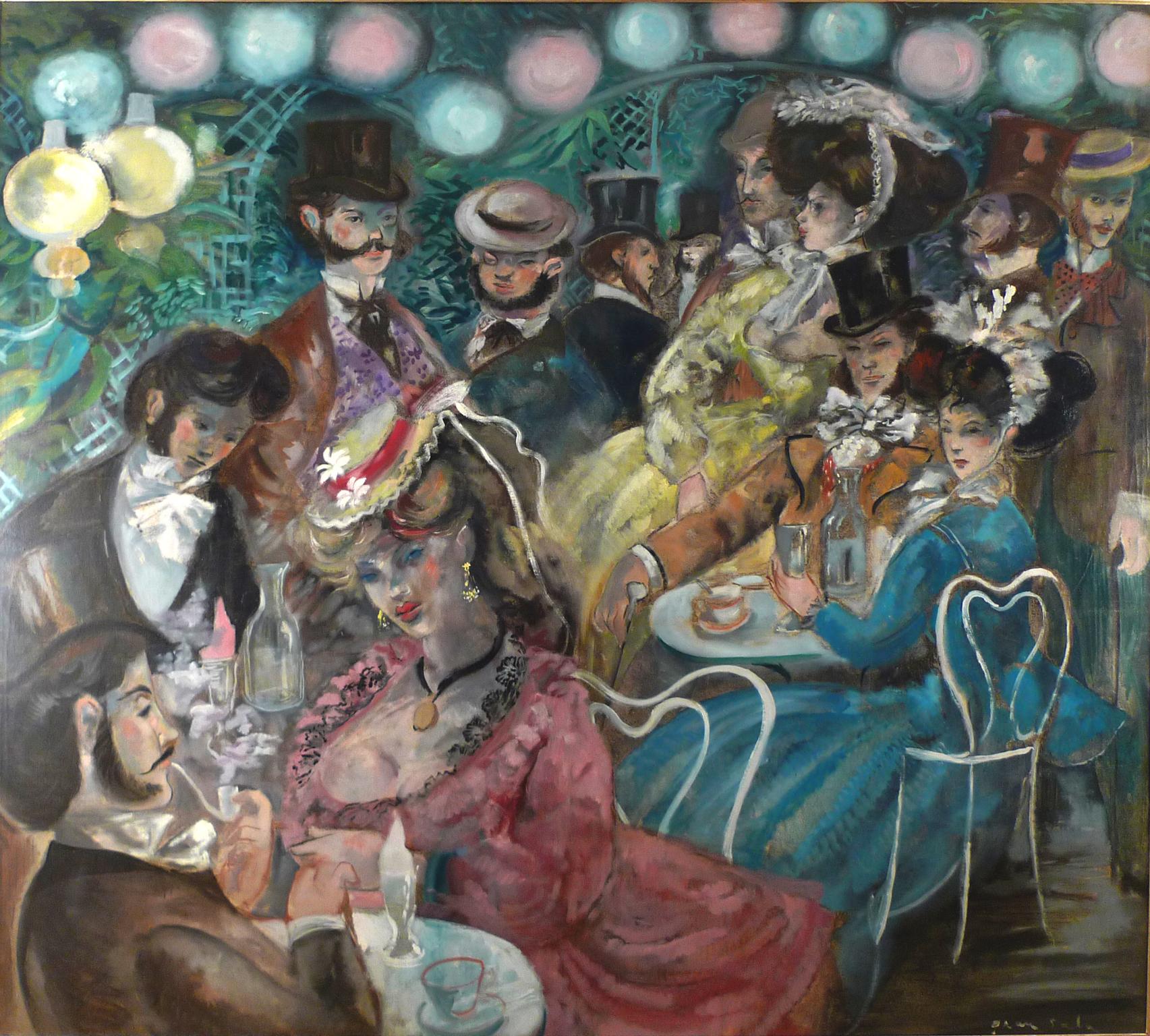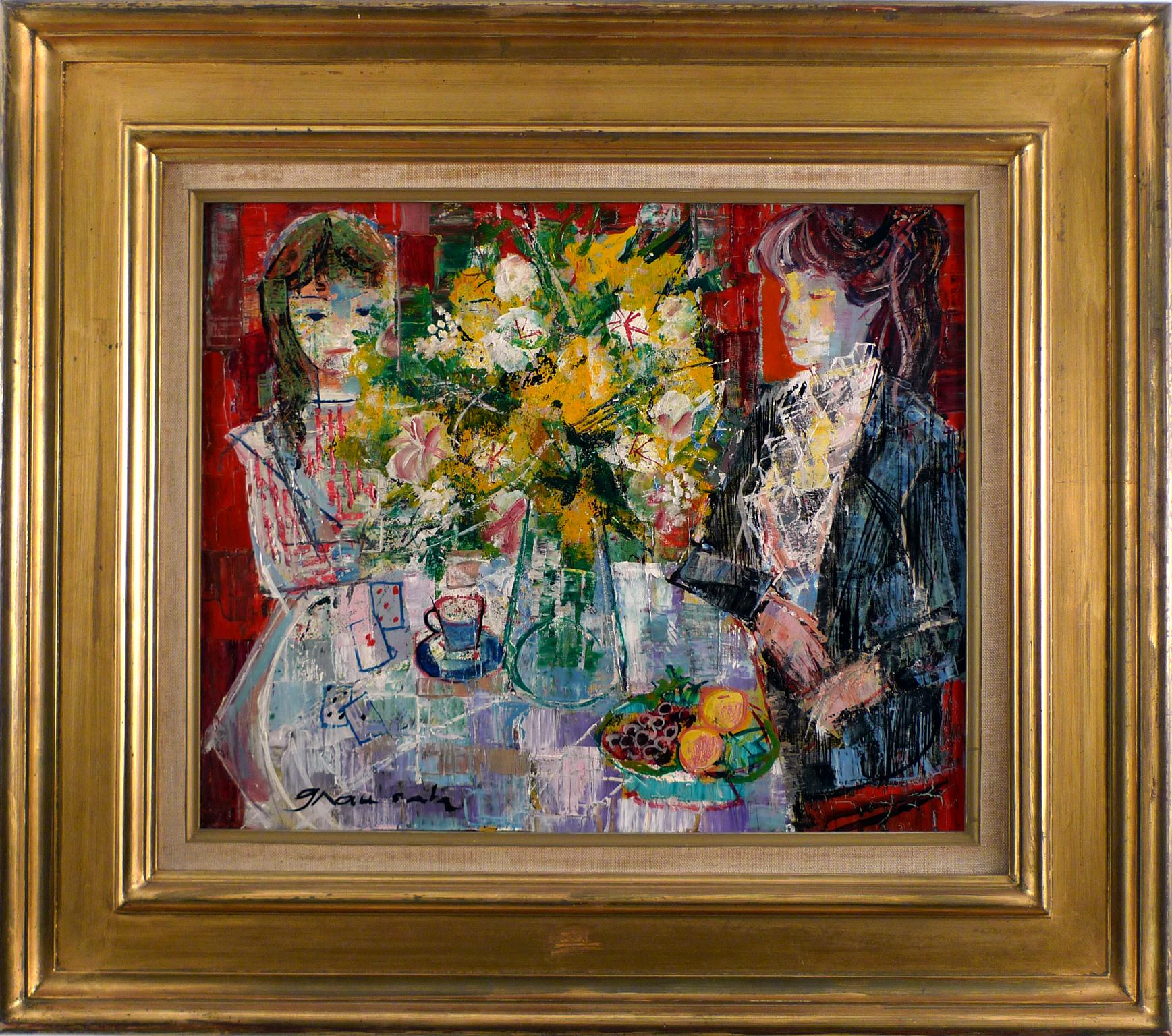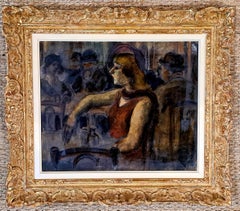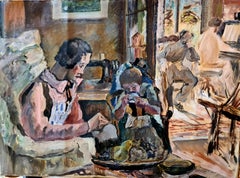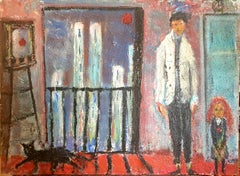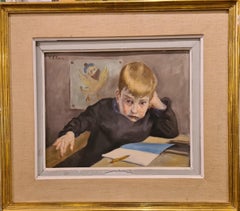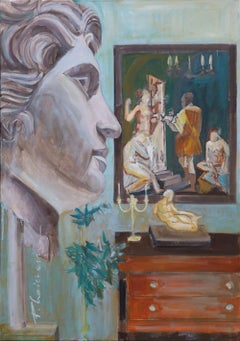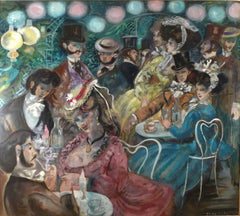Artículos similares a Ecole de Paris, Post Impressionist Portrait of a Mother and Child
Cargando vídeo
¿Quieres más imágenes o vídeos?
Solicita imágenes o vídeos adicionales al vendedor
1 de 23
Pere Modesto Luis CreixamsEcole de Paris, Post Impressionist Portrait of a Mother and Child1950s
1950s
Acerca del artículo
Mid 20th Century oil on canvas portrait of a mother and child by the noted Franco Spanish artist Pere Modesto Luis Creixams. The painting is signed bottom left and presented in a very fine patinated wood frame.
This vibrant painting portrays an intimate moment between a mother and her child, capturing the depth of their bond. Creixams employs a dynamic palette of blues, greens, and warm earthy tones, creating a harmonious contrast that emphasizes the tenderness of their connection. The mother, clad in a vivid, multi-hued garment, appears to be in motion, her gentle gaze focused intently on the child cradled in her arms. The child, painted with delicate brushstrokes, mirrors her affectionate expression. The background features abstract floral and geometric shapes, adding depth and complexity. The expressive use of brushwork and colour conveys emotion, movement, and warmth. This painting stands as a timeless celebration of maternal love and the nuances of human emotion. Its captivating composition invites viewers to engage with the serene yet dynamic energy of the scene.
Pere Créixams (9 November 1893 – 1965) was a Spanish painter and illustrator.
A figurative and self-taught painter, his work reflects both the sources of the School of Paris and Catalan painting. Throughout his life, he divided his time, between Spain, his native country, and France, his adopted country.
Pere Créixams began his studies at the Escuela Moderna (the Modern School).
He travelled in 1917 to Paris, in Montparnasse. He made his debut with François Bernouard, at La Belle Édition in 1917. The meeting with the writer Florent Fels was decisive. He introduced him to all of intellectual Paris: the poet, art critic and writer André Salmon who nicknamed him Pierre the Printer, the Swiss writer Blaise Cendrars, Max Jacob, André Malraux, Raymond Radiguet, André Salmon and the painter Amedeo Modigliani.
Creixams continued his art under the advice of the painter Othon Friesz and it was the time of his first successes. He exhibited in 1921 at the Café du Parnasse and at the Galerie Montaigne in Paris. His portraits of women are marked by the style of the illustrious representative of the School of Paris, Amedeo Modigliani.
Florent Fels introduced him to the famous Parisian art dealer Paul Guillaume, who was located at 39, rue La Boétie. The latter offered to sign a contract to commit to delivering all his artistic production to him from November 1921 to June 1922. Creixams' paintings are exhibited alongside those of André Derain, Pablo Picasso, Maurice de Vlaminck, Henri Matisse and Amedeo Modigliani...
Subsequently, Creixams worked with the gallery owner Pierre Loeb with whom he signed a contract in 1925. Located at the corner of Rue de Seine and Rue des Beaux-Arts, the famous Pierre Gallery which, from 1927 to 1963, represented many artists who marked the twentieth century (Braque, Klee, Chirico, Derain, Dufy, Gromaire, Léger, Miro, Pascin, Picasso, Soutine, Masson, Man Ray...)
In painting, he turned to his Spanish ancestors, El Greco, Francisco de Goya, Diego Velázquez in order to affirm their artistic heritage. His admiration for Pablo Picasso was also felt in his production of the 1920s and he learned the lesson of the painter of the poor, the acrobats and the guitarists.
From 1922, he settled in Montmartre and frequented the former members of the Bateau-Lavoir such as Pablo Picasso, Max Jacob, André Salmon. His friends in Florent Fels' literary circle supported him and Creixams then became friends with writers. The painter became an illustrator and collaborated with the writer and publisher duo Pascal Pia and René Bonnel on the unpublished poem by Charles Baudelaire, published from the original manuscript, which he adorned with eight etchings.
In 1928, he exhibited at the Salon d'Automne and also took part in the Salon des Indépendants and the Salon des Tuileries.
Creixams made a name for itself by exhibiting in Parisian galleries and salons. (Salon des Indépendants, Salon d'Automne, Salon des Tuileries). In Paris, he befriended Catalan artists, like him exiled, or staying in the French capital, such as Joaquín Torres García, Eugenio d'Ors and Joan Miró. In Barcelona, in the same way, Creixams maintained friendships. His meeting with the critic and painter Rafael Benet opened the doors to the Barcelona artistic world. Creixams was a total success: he was presented in the city's avant-garde galleries, in salons and his works attracted the eye of collectors (Galeríe Dalmau, Sala Parés, Syra Art Galleries). He exhibits his works regularly at the Exposició de Primavera [Spring Exhibition], Saló de Montjuïc.
Creixams' painting was first inspired by the Catalan noucentista. This movement, which began around 1906 and lasted until the beginning of the civil war in 1936, was artistic and political and proposed a renewal of society. Eugenio d'Ors, the theoretician of this new aesthetic, wanted an artistic regeneration in Catalonia. Then Creixams quickly evolved towards a popular and direct realism claimed by the new generation of artists called Generació del 17. His landscapes are very constructed, geometrized, the result of a great admiration for Paul Cézanne.
Creixams' attachment to his country was manifested in regular visits to Catalonia throughout his life. The summer period was privileged and the small fishing village of Tossa de Mar welcomed the artist during many stays. These returns to Catalonia bring Creixams a new inspiration and a more personal style. Tossa, a haven of peace and a site of great beauty, became a real artistic and intellectual centre under his leadership. Creixams and Benet brought with them their Catalan friends: Emili Bosch Roger, Francesc Camps Ribera, Josep Gausachs, Francesc Domingo, Josep Mompou, Manuel Humbert, Emili Grau Sala, Enric Casanovas. But the attraction went beyond the Catalan borders thanks to the knowledge of the artist who invited his Parisian friends, writers, led by Florent Fels, Georges Charensol, Georges Duthuit and artists such as Albert Marquet, Roger Wild, Georges Kars and Marc Chagall.
After spending the summer of 1934 in Tossa in the company of many artists, Creixams did not return to Paris and remained in Catalonia until 1937. In fact, he was appointed professor at the Escola Superior de Paisatge d'Olot. Then came the year 1937, marking a historical and political turning point for Catalonia and Spain. Creixams is artistically committed to the Republicans. It was at that time that the Catalan government chose him to illustrate a propaganda work published by the Commissariat de Propaganda de la Generalitat.
He experienced the first armed clashes in Barcelona, but finally, as the situation deteriorated, he returned to live in Paris on February 20, 1937. He left Catalonia in the middle of the civil war and only returned after an eleven-year exile. Following his committed drawings, in 1939 he produced canvases illustrating the Retirada depicting the flight to France of thousands of Spanish Republicans.
This return to France, during the Second World War, and the period of the Occupation were difficult. But Montmartre once again welcomed him with open arms and Creixams met up with his friends from the Butte, writers, painters and songwriters. He then became an essential figure in Montmartre alongside Marcel Aymé, Pierre Mac-Orlan, Gen Paul among others. The traditional party atmosphere that reigns in Montmartre suits the bon vivant character of Creixams perfectly. The distance from his native country for several years resulted in a painting with deep Spanish accents.
Creixams,in 1938, again participated in the various Parisian salons. In addition, he exhibits as a Montmartre artist in group exhibitions but also alongside his Catalan compatriots. Regular solo exhibitions are devoted to him by Parisian galleries. (Delpierre Gallery, Petridès Gallery, Élysée Gallery, Charpentier Gallery...)
Around 1940, Creixams met Nana de Herrera (1905-1991) and from their love was born a child, Ramon de Herrera. Nana de Herrera, a major figure in Parisian social life during the Roaring Twenties, is a Spanish classical ballet dancer. She was the model for Max Ponty for his design of the famous Gitanes cigarette packet (from the Seita). She also played a few film roles, both before and after the war. It is famous, among other things, for the portrait made by Tamara de Lempicka in 1928 at the request of the Austro-Hungarian Baron Raoul Kuffner. A distant echo of Joël Martel's advertisement that depicted her in a dance posture in 1926, Lempicka's painting seems to have been made to emphasize her personality.
Creixams began a career as a society portraitist in the 1940s. He frequented the world of theatre and cinema. His favourite subjects are evocations of Spain. Gypsies, majas, dancers, bullfighters evolve between reality and fantasy. During the Occupation, Creixams frequented the Lapin Agile with the painter Gen Paul at 4, rue des Saules and the restaurants Chez Manière, rue Caulaincourt and Chez Pomme. At the end of the 1940s, Gen Paul invented his "Chignolle à Gégène", a sort of thunderous brass band, in which he would lead all the artists of Montmartre: Créixams, Frank-Will, Tony Agostini, Roger Bertin, Jean d'Esparbès...
- Creador:Pere Modesto Luis Creixams (1893 - 1965, Español)
- Año de creación:1950s
- Dimensiones:Altura: 96 cm (37,8 in)Anchura: 83 cm (32,68 in)Profundidad: 5 cm (1,97 in)
- Medio:
- Movimiento y estilo:
- Época:
- Estado:Tiny area of paint loss above head of mother, some bruising to canvas and fold, centre, against the stretcher which will disappear with humidity.
- Ubicación de la galería:Cotignac, FR
- Número de referencia:Vendedor: LG/Creixams1stDibs: LU1430216378302
Sobre el vendedor
5,0
Vendedor Platino
Vendedores premium con una calificación de +4,7 y tiempos de respuesta de 24 horas
Establecido en 2000
Vendedor de 1stDibs desde 2020
241 ventas en 1stDibs
Tiempo de respuesta usual: <1 hora
- EnvíoRecuperando presupuesto…Envío desde: Cotignac, Francia
- Política de devolución
Partes de esta página se han traducido automáticamente. 1stDibs no puede garantizar la exactitud de las traducciones. El inglés es el idioma predeterminado de este sitio web.
Garantía de autenticidad
En el improbable caso de que haya algún problema con la autenticidad de un artículo, ponte en contacto con nosotros en un plazo de 1 año para recibir un reembolso total. DetallesGarantía de devolución de dinero
Si tu artículo no es como se describe, sufre daños durante el transporte o no llega, ponte en contacto con nosotros en un plazo de 7 días para recibir un reembolso total. DetallesCancelación dentro de las 24 horas
Tienes un período de gracia de 24 horas para reconsiderar tu compra, sin preguntas.Vendedores profesionales aprobados
Nuestros vendedores de primera clase deben cumplir estrictos estándares de servicio para mantener la integridad de nuestros anuncios.Garantía de igualación de precios
Si encuentras que un vendedor publicó el mismo artículo por un precio menor en otro lado, igualaremos ese precio.Entrega global de confianza
Nuestra red de transporte de primera ofrece opciones de envío especializado en todo el mundo, que incluye envío personalizado.Más de este vendedor
Ver todoPost Impressionist Bar Scene, Le Cafe du Commerce, Oil on Board
Early 20th Century oil on board interior bar scene by Simon Joseph Simon-Auguste. The painting is signed bottom right and presented in a fine gilt carved wood Montparnasse frame. The...
Categoría
mediados del siglo XX, Posimpresionista, Pinturas figurativas
Materiales
Óleo
Óleo francés de mediados de siglo sobre lienzo, Interior, La Famille, Círculo de Henri Matisse
Óleo sobre lienzo francés de mediados de siglo de una familia en una escena interior por Léon Nancey. Aunque no está firmado, el cuadro se adquirió directamente en el taller del arti...
Categoría
mediados del siglo XX, Pinturas figurativas
Materiales
Lienzo, Óleo
Gran óleo expresionista sobre lienzo, Interior de apartamento y paisaje urbano. Aceite.
Por Ernst Ludwig Kirchner
Óleo expresionista sobre lienzo de mediados de siglo que representa a un hombre, un niño y un gato en un interior con un paisaje urbano más allá. La obra no está firmada pero hay var...
Categoría
mediados del siglo XX, Expresionista, Pinturas figurativas
Materiales
Óleo, Lienzo
2240 US$ Precio de venta
Descuento del 20 %
El Pato Donald y Le Petit Ecolier, Óleo sobre tabla de principios del siglo XX.
Retrato al óleo sobre tabla de principios del siglo XX de un joven colegial "Le Petit Écolier", con el Pato Donald, de Pierre Villain (francés, 1880-1950). Firmado arriba a la derech...
Categoría
principios del siglo XX, Realista, Pinturas figurativas
Materiales
Óleo, Tablero
Pierre VillainEl Pato Donald y Le Petit Ecolier, Óleo sobre tabla de principios del siglo XX., 1930s
728 US$ Precio de venta
Descuento del 48 %
Escena Interior de Finales de Siglo Medio, Una Villa en Cannes, Sur de Francia. Óleo, cartón
Óleo sobre tabla de finales del siglo XX de una escena interior con figura femenina sentada, por Bill Brown. Iniciales firmadas y fechadas 76 abajo a la derecha y tituladas al dorso ...
Categoría
Década de 1970, Moderno, Pinturas figurativas
Materiales
Óleo, Tablero
Acrílico sobre tabla expresionista abstracto francés de finales del siglo XX. Noche de jazz'.
Por Thierry Miramon
Óleo expresionista abstracto sobre tabla de finales del siglo XX, representación de una animada noche de jazz del artista francés Thierry Miramon, firmado arriba a la izquierda y pre...
Categoría
finales del siglo XX, Expresionista, Pinturas figurativas
Materiales
Tablero, Acrílico
980 US$ Precio de venta
Descuento del 30 %
También te puede gustar
Mirando al mundo
Por Paula Craioveanu
Óleo sobre lienzo
Categoría
Siglo XXI y contemporáneo, Fauvista, Pinturas de interiores
Materiales
Lienzo, Óleo
3040 US$ Precio de venta
Descuento del 20 %
Paddock
Por Emilio Grau Sala
EMILIO GRAU SALA
Español, 1911 - 1975
PADDOCK
firmado "Grau Sala" (abajo a la derecha)
óleo sobre lienzo
54 x 65 cm (21-1/3 x 25-1/2 pulgadas)
enmarcado: 70 x 81 cm (27-1/2 x 32 pulg...
Categoría
Década de 1960, Posimpresionista, Pinturas figurativas
Materiales
Lienzo, Óleo
"Le Moulin de la Galette", Gran óleo sobre lienzo del siglo XX de Emilio Grau Sala
Por Emilio Grau Sala
EMIILIO GRAU SALA
Español, 1911 - 1975
LE MOULIN DE LA GALETTE
firmado Grau Sala (abajo a la derecha)
óleo sobre lienzo
59-1/4 X 67-1/4 pulgadas (150,5 X 170 cm.)
enmarcado: 158 X 1...
Categoría
Década de 1930, Posimpresionista, Pinturas figurativas
Materiales
Lienzo, Óleo
"Espagnoles, 1971", óleo sobre lienzo del siglo XX del artista Emilio Grau Sala
Por Emilio Grau Sala
EMILIO GRAU SALA
Español, 1911 - 1975
ESPAGNOLES, 1971
firmado "Grau Sala" (abajo a la izquierda)
firmado de nuevo, fechado y titulado "Grau Sala, 1971, espagnoles" (en el reverso)...
Categoría
Década de 1970, Posimpresionista, Pinturas figurativas
Materiales
Lienzo, Óleo
"Interieur aux Fleurs Jaunes" Siglo XX Óleo sobre lienzo de Emilio Grau Sala
Por Emilio Grau Sala
EMILIO GRAU SALA
Español, 1911 - 1975
INTERIEUR AUX FLEURS JAUNES
firmado "Grau Sala" (abajo a la izquierda)
firmado de nuevo, localizado, fechado y titulado "Grau Sala, París 61, In...
Categoría
Década de 1960, Fauvista, Pinturas de interiores
Materiales
Lienzo, Óleo
Mujer en mecedora óleo sobre lienzo pintura fauvismo desnudo
Por Jordi Curos
Jordi Curós Ventura (1930-2007) - Mujer en mecedora - Óleo sobre lienzo.
Medidas de la obra 61x46 cm.
Sin marco.
Jordi Curós Ventura (Olot, Girona, 4 de marzo de 1930) es un pintor ...
Categoría
Década de 1970, Fauvista, Pinturas figurativas
Materiales
Óleo, Lienzo

